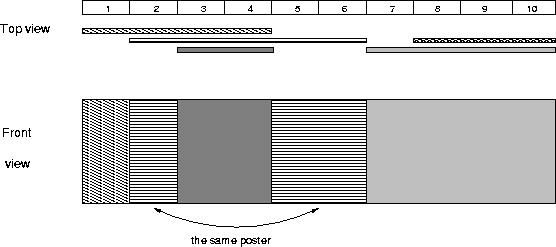POJ 2528 && NYOJ 9 离散化+线段树
2012-04-19 16:39 javaspring 阅读(266) 评论(0) 收藏 举报POJ此题数据巨水,大家可以到NYOJ上提交以下,看看写的程序到底对不对。这题就是线段树,其次要离散化一下,我是第一次写离散化的题目,长记性了。离散化的时候因为把实际值映射成了另一个值,所以最后映射的值最多有多少个就需要考虑清楚,开线段树数组的时候要注意这点。我就是因为这里re了好几次。
离散化后找应设值的时候用二分查找,因为总数不多,所以用二分来说是比较快的,之后就是线段树的普通操作了,其中用到了lazy思想,今天中午mdd又给我讲了下lazy思想,差不多是理解了。最后的时候遍历统计有几张海报即可。题目:
Mayor's posters
| Time Limit: 1000MS | Memory Limit: 65536K | |
| Total Submissions: 24963 | Accepted: 7221 |
Description
The citizens of Bytetown, AB, could not stand that the candidates in the mayoral election campaign have been placing their electoral posters at all places at their whim. The city council has finally decided to build an electoral wall for placing the posters
and introduce the following rules:
They have built a wall 10000000 bytes long (such that there is enough place for all candidates). When the electoral campaign was restarted, the candidates were placing their posters on the wall and their posters differed widely in width. Moreover, the candidates started placing their posters on wall segments already occupied by other posters. Everyone in Bytetown was curious whose posters will be visible (entirely or in part) on the last day before elections.
Your task is to find the number of visible posters when all the posters are placed given the information about posters' size, their place and order of placement on the electoral wall.
- Every candidate can place exactly one poster on the wall.
- All posters are of the same height equal to the height of the wall; the width of a poster can be any integer number of bytes (byte is the unit of length in Bytetown).
- The wall is divided into segments and the width of each segment is one byte.
- Each poster must completely cover a contiguous number of wall segments.
They have built a wall 10000000 bytes long (such that there is enough place for all candidates). When the electoral campaign was restarted, the candidates were placing their posters on the wall and their posters differed widely in width. Moreover, the candidates started placing their posters on wall segments already occupied by other posters. Everyone in Bytetown was curious whose posters will be visible (entirely or in part) on the last day before elections.
Your task is to find the number of visible posters when all the posters are placed given the information about posters' size, their place and order of placement on the electoral wall.
Input
The first line of input contains a number c giving the number of cases that follow. The first line of data for a single case contains number 1 <= n <= 10000. The subsequent n lines describe the posters in the order in which they were placed. The i-th line among
the n lines contains two integer numbers li and ri which are the number of the wall segment occupied by the left end and the right end of the i-th poster, respectively. We know that for each 1 <= i <= n, 1 <= li <= ri <= 10000000. After
the i-th poster is placed, it entirely covers all wall segments numbered li, li+1 ,... , ri.
Output
For each input data set print the number of visible posters after all the posters are placed.
The picture below illustrates the case of the sample input.

The picture below illustrates the case of the sample input.

Sample Input
1 5 1 4 2 6 8 10 3 4 7 10
Sample Output
4ac代码:
#include <iostream>
#include <cstdio>
#include <string.h>
#include <algorithm>
using namespace std;
const int N=10010;
struct tree{
int left,right,num;
}tt[16*N];
int xx[N*4],yy[4*N],value[4*N],flag[4*N],ans;
void built_tree(int lp,int rp,int pos){
tt[pos].left=lp;
tt[pos].right=rp;
tt[pos].num=0;
if(lp==rp)return;
int mid=(tt[pos].left+tt[pos].right)/2;
built_tree(lp,mid,pos*2);
built_tree(mid+1,rp,pos*2+1);
}
int find(int x,int lp,int rp){
while(lp<=rp){
int mid=(lp+rp)/2;
if(value[mid]==x)return mid;
else if(value[mid]>x) rp=mid-1;
else lp=mid+1;
}
return -1;
}
void add(int lp,int rp,int id,int pos){
if(lp<=tt[pos].left&&rp>=tt[pos].right){
tt[pos].num=id;
return;
}
if(tt[pos].num){
tt[2*pos].num=tt[2*pos+1].num=tt[pos].num;
tt[pos].num=0;
}
int mid=(tt[pos].left+tt[pos].right)/2;
if(lp<=mid)
add(lp,rp,id,pos*2);
if(rp>mid)
add(lp,rp,id,pos*2+1);
}
void query(int lp,int rp,int pos){
if(tt[pos].num){
if(!flag[tt[pos].num]){
ans++;
flag[tt[pos].num]=1;
}
return;
}
if(lp==rp)return;
int mid=(tt[pos].left+tt[pos].right)/2;
query(lp,mid,2*pos);
query(mid+1,rp,2*pos+1);
}
int main(){
freopen("1.txt","r",stdin);
int numcase;
scanf("%d",&numcase);
while(numcase--){
int n,pos=1;
scanf("%d",&n);
for(int i=1;i<=n;++i){
scanf("%d%d",&xx[i],&yy[i]);
value[pos++]=xx[i];
value[pos++]=yy[i];
}
//built_tree(1,N,1);
//离散化
sort(value+1,value+pos);
int kk=2;
for(int i=2;i<pos;++i){
if(value[i]!=value[i-1]){
value[kk++]=value[i];
}
}
for(int i=kk-1;i>1;--i){
if(value[i]!=value[i-1]+1){
value[kk++]=value[i-1]+1;
}
}
sort(value+1,value+kk);
built_tree(1,kk-1,1);
for(int i=1;i<=n;++i){
int newx=find(xx[i],1,kk-1);
int newy=find(yy[i],1,kk-1);
add(newx,newy,i,1);
}
memset(flag,0,sizeof(flag));
ans=0;
query(1,kk-1,1);
printf("%d\n",ans);
}
return 0;
}




 浙公网安备 33010602011771号
浙公网安备 33010602011771号